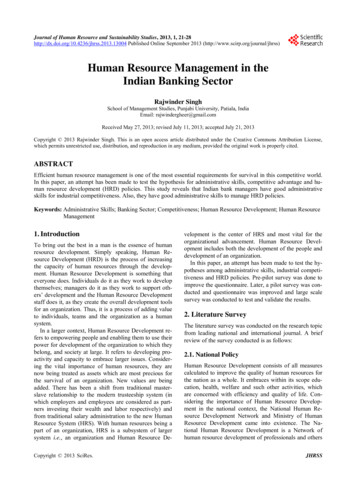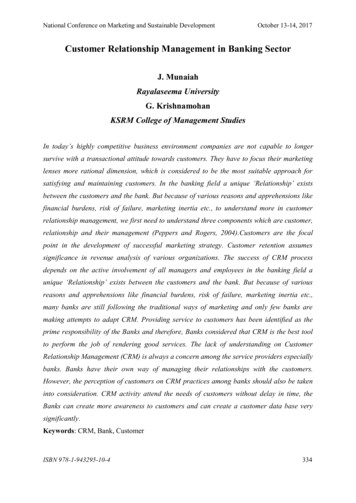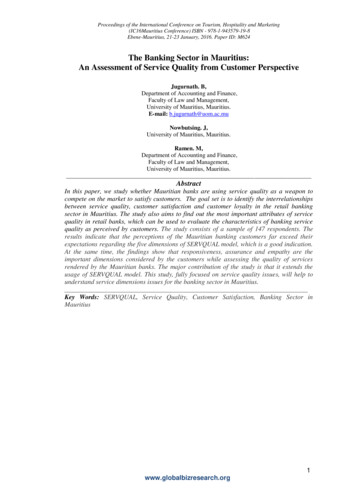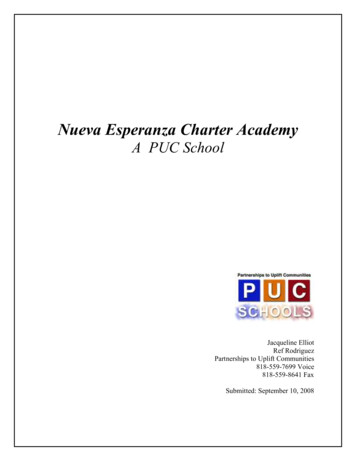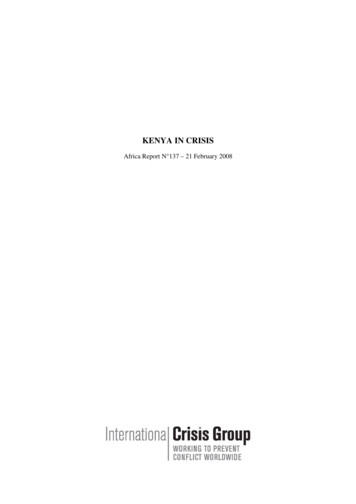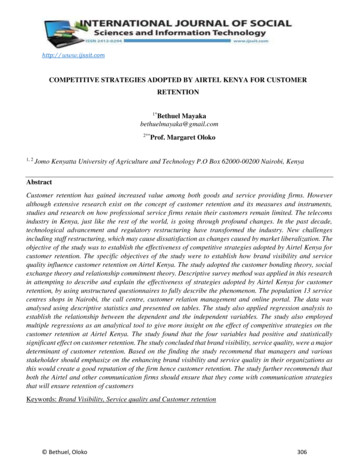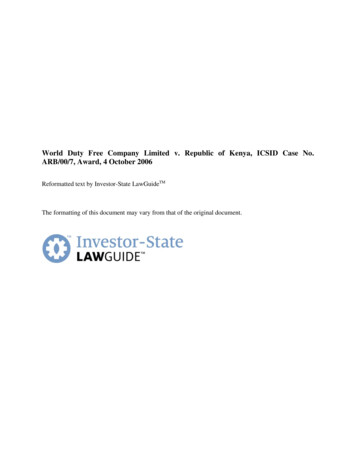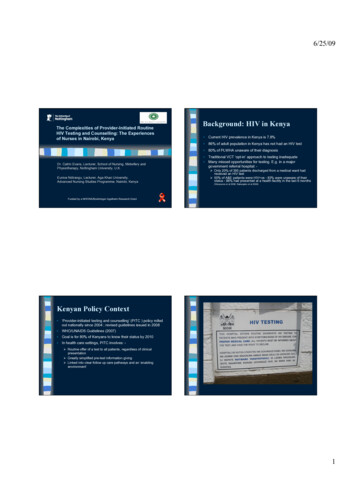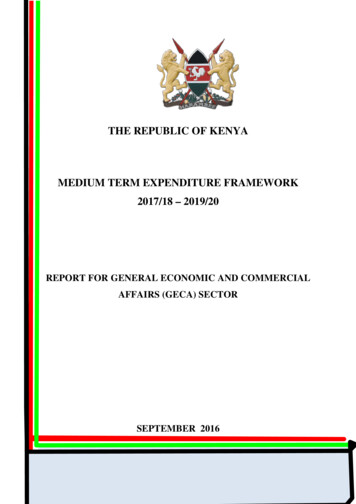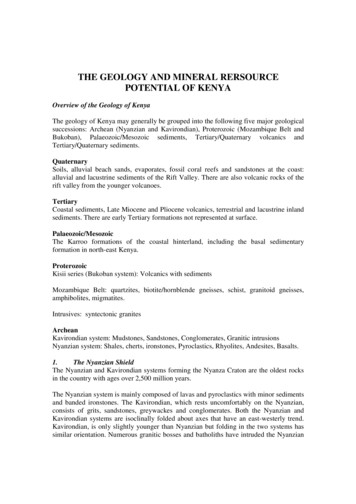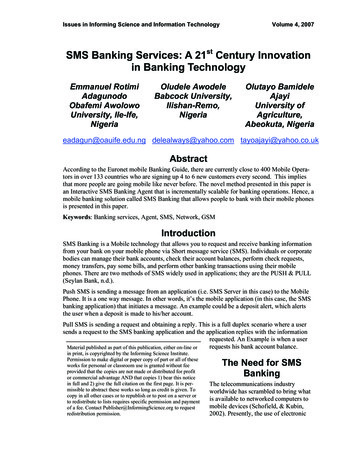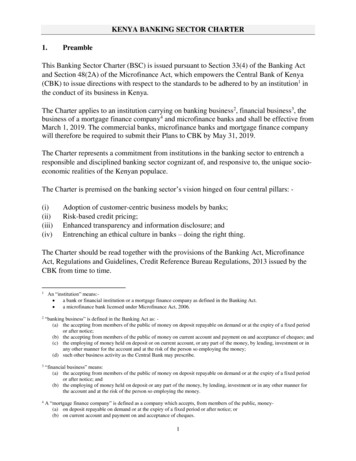
Transcription
KENYA BANKING SECTOR CHARTER1.PreambleThis Banking Sector Charter (BSC) is issued pursuant to Section 33(4) of the Banking Actand Section 48(2A) of the Microfinance Act, which empowers the Central Bank of Kenya(CBK) to issue directions with respect to the standards to be adhered to by an institution1 inthe conduct of its business in Kenya.The Charter applies to an institution carrying on banking business2, financial business3, thebusiness of a mortgage finance company4 and microfinance banks and shall be effective fromMarch 1, 2019. The commercial banks, microfinance banks and mortgage finance companywill therefore be required to submit their Plans to CBK by May 31, 2019.The Charter represents a commitment from institutions in the banking sector to entrench aresponsible and disciplined banking sector cognizant of, and responsive to, the unique socioeconomic realities of the Kenyan populace.The Charter is premised on the banking sector’s vision hinged on four central pillars: (i)(ii)(iii)(iv)Adoption of customer-centric business models by banks;Risk-based credit pricing;Enhanced transparency and information disclosure; andEntrenching an ethical culture in banks – doing the right thing.The Charter should be read together with the provisions of the Banking Act, MicrofinanceAct, Regulations and Guidelines, Credit Reference Bureau Regulations, 2013 issued by theCBK from time to time.1An “institution” means: a bank or financial institution or a mortgage finance company as defined in the Banking Act. a microfinance bank licensed under Microfinance Act, 2006.2“banking business” is defined in the Banking Act as: (a) the accepting from members of the public of money on deposit repayable on demand or at the expiry of a fixed periodor after notice;(b) the accepting from members of the public of money on current account and payment on and acceptance of cheques; and(c) the employing of money held on deposit or on current account, or any part of the money, by lending, investment or inany other manner for the account and at the risk of the person so employing the money;(d) such other business activity as the Central Bank may prescribe.3“financial business” means:(a) the accepting from members of the public of money on deposit repayable on demand or at the expiry of a fixed periodor after notice; and(b) the employing of money held on deposit or any part of the money, by lending, investment or in any other manner forthe account and at the risk of the person so employing the money.4A “mortgage finance company” is defined as a company which accepts, from members of the public, money(a) on deposit repayable on demand or at the expiry of a fixed period or after notice; or(b) on current account and payment on and acceptance of cheques.1
2.BackgroundThere have been concerns by the public on the high cost of credit charged by the bankingsector and poor customer service. These concerns have led to significant loss of trust inbanks by the public. The Government and the Central Bank of Kenya have, in the recentpast, introduced several reforms to lower the cost of credit. The reforms include: roll out ofmobile phone financial services in 2007, establishment of currency centers in 2009, agencybanking in 2010, introduction of the Credit Information Sharing (CIS) mechanism in 2010,and the Kenya Banks Reference Rate in 2014. These initiatives however have not addressedsufficiently these concerns particularly the high cost of credit.There have been further developments made in the banking sector as a result of the ongoingregulatory reforms aimed at strengthening consumer protection and helping improvetransparency and competition in the sector. These include; enhancing the CIS framework,review of the consumer protection framework, implementing the movable collateral registry(Movable Property Security Rights Act, 2017), increasing transparency of the pricing ofproducts through the launch of the total cost of credit website in 2017 and adoption ofcustomer-centric business models by banks. These and other reforms are necessary towardstransforming the banking sector to being responsible, disciplined and aligned to the needs oftheir customers.3.Kenya Banking Sector CharterIt is in the interest of the Kenyan financial sector and populace that CBK is now issuing thisKenya Banking Sector Charter. The Charter is expected to facilitate a market-driventransformation of the Kenyan banking sector and bring about tangible benefits for Kenyans.4.Objectives of the proposed Banking Sector Charteri)To increase access to affordable and appropriate banking services to the unbanked andunder-served population in Kenya.ii) To develop a more resilient, competitive and dynamic financial system based on thefour central pillars of the banking sector’s vision.iii) To ensure that institutions proactively engage their customers in financial literacy andconsumer education drives, to enhance customers’ financial knowledge and skills forthem to make informed financial decisions.iv) To ensure institutions develop and submit a time bound plan approved by theinstitution’s Board in compliance with the Charter for CBK’s monitoring purposes.v) To promote efficiency in lending and acquisition of loanable funds.2
In pursuit of these objectives, the Charter commits institutions in the banking sector totransform in the following areas: a.FairnessIn order to improve the credit risk pricing of loans extended to borrowers as well asimplement differential credit pricing, based on a customer credit rating, institutions arehenceforth mandated to implement risk based credit scoring techniques in their loanscreening processes. In order to enhance credit scoring and improve data analytics, aTechnical Working Group (TWG)5 was constituted to facilitate standardization of creditscores among credit reference bureaus (CRBs). Subsequent to this harmonization, institutionswill be required to source for credit scoring rating from any of the licensed CRBs with anoption of complementing the CRB’s rating with their internal credit scores for effective riskmanagement.CRBs have enriched datasets as compared to individual institutions as they collect creditinformation from both institutions and other third party data sources; availing comprehensiveinformation for sound decision making. The use of appropriate credit scoring techniques shall be ascertained by CBK throughvarious avenues, including during on-site examinations and through conducting consumerprotection diagnostic exercises like mystery shopping surveys.To enhance fairness, it is also critical to ensure that transparency and full disclosure of theterms and pricing of products is implemented. In line with the Prudential Guideline onConsumer Protection Guideline and Consumer Protection Act, 2012, institutions arehenceforth required to publish in their respective websites and places of business: Key fact statements (KFS) of all products to be developed in line with the RiskManagement Guideline on Credit Risk Management as well as Prudential Guideline onConsumer Protection. The key features expected to be included in a KFS include: type ofproduct, costs, target clientele, risks, rights and obligations of the parties and legibility ofthe statement in terms of use of simple language and easy format. For digital products,provision of the abridged version of the terms and conditions to consumers usingUnstructured Supplementary Service Data (USSD) format is critical before acceptance ofthe product. Terms and conditions of their products including, but not limited to,allowance of cooling off period, customer complaint processes, protection of consumerdata and privacy should be disclosed. Full disclosures should be included indocumentation such as credit agreements, key fact statements and websites. Abridgedversions of the salient features to be placed in the places of businesses (outlets, marketingoffices, agents, headquarters and branches).5The TWG comprises of representatives from selected commercial banks and microfinance banks, Credit Information SharingAssociation of Kenya (CIS-Kenya), Kenya Bankers Association (KBA), World Bank, Credit Reference Bureaus (CRBs) andCentral Bank of Kenya (CBK).3
Complaints handling and consumer recourse mechanisms.o An institution, on receiving a complaint, shall provide the complainant with a promptwritten acknowledgement6 within 48 hours and resolve the complaint in 7 workingdays. For complaints not resolved within 7 working days, written updates should beforwarded to the customer on the progress in resolving the complaint, once in everyseven days.b.TransparencyA joint initiative by the Kenya Bankers Association and the Central Bank of Kenya (CBK),to enhance transparent pricing reporting was launched in June 2017. Some commercial banksare yet to upload their charges and fees to the website which is aimed at enhancingtransparency in the pricing of credit.It is against this backdrop that CBK now mandates all commercial banks to upload theirrespective internal and external fees7 for all products on the cost of credit website toenable customers make rational financial (product) decisions. The institutions will be heldliable on any erroneous or outdated data posted in the website arising from the institutions’errors. Failure to adhere to this clause will result to administrative sanctions as embedded inSection 49 of the Banking Act.Further the Banking industry should begin to move towards the development of a BankingServices Pricing Index. The index will help in: oMeasuring the weighted average of prices of a basket of banking services, such asdirect and intermediation prices. This will be calculated by taking price changes foreach banking service in the predetermined basket of banking services and averagingthem.Comparing between prices of banking services for any two periods.Comparing between prices of banking services for any two institutions.oo6Written communication consists of: 7registered mail or certificate of posting;e-mail;short message service through the customer’s registered telephone number; orphysical delivery of the letter evidenced by acknowledgement of receipt by the customer or his nominee, where thephysical address of the customer is known.External loan-related fees charged by third party service providers (such as legal, valuation, insurance, stamp duty) to be in linewith the prescribed Remuneration Orders for the various services offered by the third party service providers.4
c.Financial LiteracyAs banking services and products become sophisticated and widespread throughout thecountry, financial literacy8 will need to be addressed in order to ensure proper use of theavailable banking services and products offered by institutions. Increases in access tobanking services along with rapid growth of the financial sector, will cause more consumersto be exposed to risks that these products/services pose through their normal use. Improvedinformation disclosure may be counterproductive if the information disclosed is notunderstood by consumers with low level of financial literacy.In this regard, institutions should: Facilitate technical assistance through appropriate financial literacy9 to potential andexisting customers in the Micro, Small and Medium Enterprises (MSMEs) sector in aneffort to enhance their financial skills necessary to secure and utilize finances. Develop financial literacy initiatives that are distinct from the common productadvertising and marketing, and that are more targeted, strengthened and coordinated tohave greater impact in terms of effectiveness and efficiency. The financial literacyinitiatives will be unique to a bank based on the adopted business model and strategy.d.Financial AccessThe Banking Sector Charter is intended to broaden and hasten the transformation process ofthe banking industry into a responsible and disciplined industry. This will be through a focuson making banking services accessible to the previously unbanked and under-served throughthe provision of affordable financing of MSMEs and other underserved segments of theKenyan economy.To broaden the outreach of banking services, there is need for institutions to embrace newbusiness models deploying technologies and risk management systems to serve all consumersegments, particularly the un-banked and under-banked. Therefore, the business models ofbanks should be innovative, responsive and dynamic to address the specific needs of theircustomers.In this regard, institutions should demonstrate:oooConsumers input towards the development of the product are considered;Strategic benefit of the product to the consumer is evidenced;Required resources and competences to offer the products sustainably are available; and8The Organization for Economic Cooperation and Development (OECD) has defined financial literacy as follows: 'Acombination of awareness, knowledge, skill, attitude and behavior necessary to make sound financial decisions and ultimatelyachieve individual financial wellbeing.'9Financial literacy helps in empowering and educating MSMEs so that they are knowledgeable about finance in a way that isrelevant to their business and enables them to use this knowledge to evaluate products and make informed decisions. (Source:International Journal of Economics, Finance and Management Sciences 2017; 5(3): 173-181)5
oInnovative and dynamic business models and channels are employed.Similarly, for the consumers who are perceived to be risky and thus barred from accessingbanking services optimally, credit risk reduction mechanisms such as insurance products,collateralization of transactions and risk-sharing and transfer arrangements should beconsidered and adopted.In this regard, to achieve the desired penetration of affordable and appropriate bankingservices, institutions should promote enterprise development. In this regard, each institutionto evaluate its existing processes to promote lending to MSMEs, as well as document theinitiatives that the institution is undertaking to promote access to finance for MSMEs.December 2018 will be used as a baseline.5.Compliance with CharterBanks should develop and submit to CBK a time bound plan approved by the institution’sBoard to comply with the Charter that is approved by the Board by May 31, 2019. The planis to be signed by both the Chairman and Chief Executive Officer of the institution.The plan will be used by CBK to monitor compliance and should focus on the new bankingsector vision hinged on the four key pillars: transparency, responsible pricing, customercentric models and ethical culture.6.Reporting MechanismEach institution shall submit a quarterly report to CBK on the progress of its implementationof the Charter within 10 days after the end of every calendar quarter.7.Remedial MeasuresCBK may assess and levy monetary penalties as provided for under the Banking Act andMicrofinance Act against any institution that violates, contravenes or otherwise fails tocomply with the Charter. In addition, CBK may pursue any or all remedial actions and takesuch other administrative actions as it may deem appropriate in the circumstances.8.Effective DateThe Charter is effective from March 1, 2019.CENTRAL BANK OF KENYAFEBRUARY 20196
Glossary of Terms1. Agent banking is an alternative delivery channel for offering banking services in a costeffective manner using entities contracted by an institution to provide specified bankingservices on its behalf.2. Banking Services Pricing Index – is a measure that examines the weighted average offinancial services and products prices over time.3. Cooling off Period refers to the time allowed under law to enable a consumer to cancelan agreement without incurring any penalty.4. Credit risk reduction mechanisms – refers to risk management techniques used byfinancial institutions to mitigate their credit risks exposures.5. Customer Centricity is a deliberate strategy by financial institutions that seeks to reorient their entire operating business model around the customer, increasing customersatisfaction and their own profitability in the process.6. Credit Information Sharing refers to a process where credit providers (such as banks,microfinance institutions, Saccos, etc.) exchange information on their outstanding loansand advances through licensed Credit Reference Bureaus (CRBs).7. Credit scoring entails use of judgment, statistics or both in predicting the customers’ability to repay a loan.8. Micro, Small and Medium Enterprises (MSMEs) - Under the Micro and SmallEnterprises (MSE) Act, 2012;Micro enterprises refer to any firm, trade, service, industry or a business activity,whether formal or informal, that has an annual turnover that does not exceed Ksh.500,000 and employing (or rather engaging) 1- 9 people. The total assets and financialinvestment or the registered capital of the enterprise does not exceed Ksh. 10 million inthe manufacturing sector and does not exceed Ksh. 5 million in the service and farmingsector.Small enterprises are those firms, trade, service, industry or business activities that postan annual turnover of between Ksh. 500,000 and Ksh. 5 million and have 10-497
employees. In the manufacturing sector, investment in plant and machinery should bebetween Ksh. 10 million and Ksh. 50 million and registered capital of the enterprisebetween Ksh. 5 million and Ksh. 25 million in the service and farming sector.9. Mystery Shopping Survey - Mystery shopping survey is a research approach that is usedto amongst others, test customer experience in obtaining services; evaluate compliancewith regulation or to gather specific information about products and services.8
The Charter is premised on the banking sector’s vision hinged on four central pillars: - (i) Adoption of customer-centric business models by banks; (ii) Risk-based credit pricing; (iii) Enhanced transparency and information disclosure; and (iv) Entrenching an ethical culture in banks – doing the right thing.
